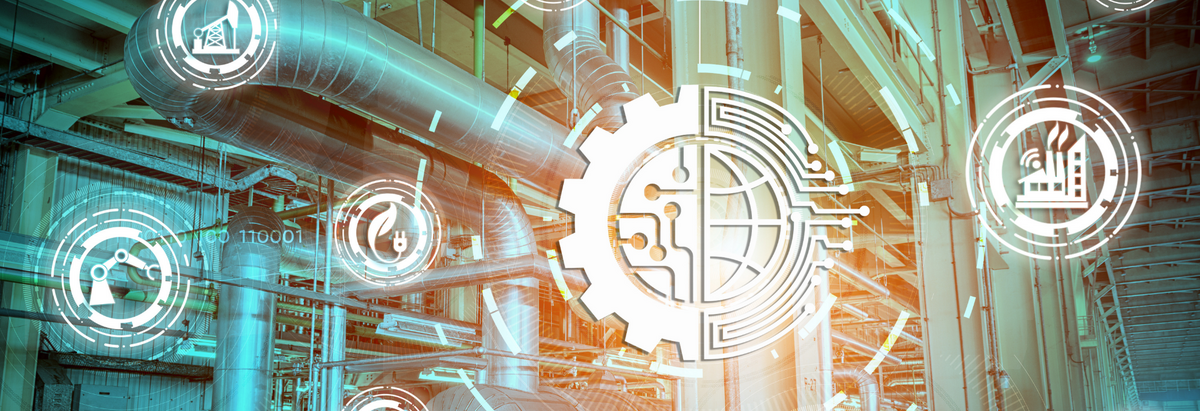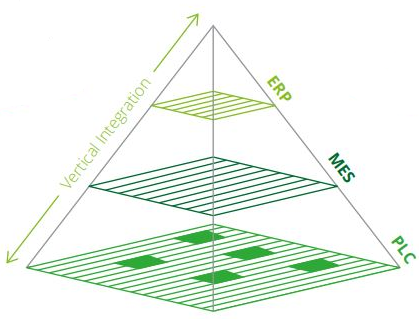New Infrastructure of Smart Industry: Intelligent Manufacturing and ERP
2019-10-10

The adoption and adaptation of new technologies are becoming the crux of current enterprise strategies. This causes the pressing need for structuralizing established hierarchy of IT systems. In the age of cyber-manufacturing and autonomization, the position of ERP systems is being reassessed to be properly integrated into the new smart industry infrastructure.
The arrival of Industry 4.0 technologies and digital transformation transfigured process management in the manufacturing and logistics industries. Enterprises are facing market pressure to promptly produce and deliver customized goods and services. Also, enterprises are obligated to constantly improve their inner processes, to optimize operating costs and achieve sustainable growth.
Adoption and adaptation of new technologies are fundamental frameworks of enterprise strategies and ultimately prompts the pressing need to re-structuralize the established hierarchy of IT systems. In the age of cyber-manufacturing and autonomization, the position of ERP systems is being reassessed to be properly integrated into the new smart industry infrastructure.
Disruption
Digitalization and new technologies that are increasingly expanding into the manufacturing and logistics industries are upsetting current enterprise models. They are fast changing the way business and supply chains function, the way people behave, how software application operates and what they are permitting, and what customers can expect and when.
Automation executed with digital technologies (cyber-automation) has completely blurred the lines between manufacturing and operational technologies (OT) and information technologies (IT), which opens a path to new business concepts and allows the reassessment of established enterprise processes. This, consequently, occasions concepts, processes, IT technology, and systems of enterprises to be outdated and obsolete. Enterprises need to prepare for a significant transformation.
Catalysts
The internet is causing rapid changes in the supply chain, industry operations management, and in the business models of enterprises. Because the internet was built as an open and easily extendable platform, it is nowadays ubiquitous. The internet is the catalyst triggering the birth of technologies like the Internet of Things (IoT), Internet of Services (IoS), or cloud computing services.
We are witnessing the emergence of API economy, where products we once bought are now services we rent (concept EaaS – Everything as a Service). This change in consumer behavior has altered the way business channels and manufacturing and logistics industries operate.
Challenges
Customers are incessantly pressuring enterprises to deliver highly customized goods and services in a timely fashion. The increasing speed of material flow means that the flow of information needs to be accelerated as well. On the other hand, the soaring availability of diverse sensors causes exponential growth of enterprise data.
The particular operations and processes, from order processing and production planning to managing large supply chains, are nowadays unfolding in real time. For that reason, timely data circulation and data distribution need to occur in as short cycles as possible. Intelligent operations management and the degree of added value an enterprise can generate depend on precise and timely data processing and their subsequent allocation.
The complex nature of manufacturing enterprises and the vast variety of its processes produce equally complex digital ecosystem. The digital ecosystem of enterprises usually consists of a plethora of mostly licensed applications, proprietary solutions, and excel tables. However, systems within the enterprise structure are yet to be arranged into several business-defined layers.
To boost the speed of transferred information, data flows between these layers need to become more dynamic. The dynamization of data flows can lead to several issues such as frequent data loss, data incompatibility during system upgrade, or data inconsistency in different databases.
Transformation
The future of responsive, effective, and high-quality manufacturing is in emerging technologies. For enterprises to mine the benefits of these technologies (benefits such as increased productivity and product quality, a vast variety of offered products, prompt delivery of product and services along operating cost optimization), there must be a drastic change in the current developmental trajectory and structure of IT systems. This change significantly influences the position of ERP systems. The current trends in IT development offer several solutions.
Decentralization
The current system is a centric structure topped by the administrative layer of ERP systems (including related systems such as SCM or CRM). The bottom automation layer consists of a cluster of interconnected operational technologies such as PLC, CNC, SCADA, and other similar systems. The Manufacturing Execution System (MES) and Manufacturing Operations Management (MOM) systems controlling the processes are wedged between the two layers.
The positioning of the layers—autonomous and basically isolated—doesn’t allow for quick manufacturing flow and affords other data with as little response time as possible. Such traditional structures, with the current position of ERP systems above the automation and controlling/managing layer, are increasingly becoming a burden and hinders the development of necessary infrastructures.
For a change in the model related to the emergence of interconnected and digitalized enterprise (factory), the management of data flow needs to be transformed as well. This explains why, nowadays, the traditional models of data management are being revised—to better suit the challenges posed by interoperable systems and their integrability.
ERP systems are also playing a really crucial role in transforming the outmoded traditional centrist hierarchy into a decentralized architecture. Thanks to this shift, data are getting closer to the spots and nodes where relevant decision-making processes are taking place.
Decentralization refers to the ability of individual system elements to make decisions autonomously, in achieving a shared goal or task. This transformation is engineered by Smart Industry systems built on the principles of modern Manufacturing Operations Management (MOM) systems.
Their basis is information infrastructure, which allows the creation of cyber-physical production systems. Such a system, in its core, is not centralized because it is designed and constructed as mutually interconnected micro-applications (or intelligent information agents) that represent physical objects and non-physical entities in the virtual layer. The traditional hierarchy is thus replaced by a network of partial logic services.
For non-centrist structure and assurance of autonomy in individual decision-making processes, ERP systems also need to be broken down into services. In new structures, data achieve added value that is being valorized in individual decision-making processes since these data permit intelligent and agile manufacturing and logistics management in real time.
Re-building data infrastructure, from one central storage (data silos) into a heterogeneous network, will eventually attain administrative and managing/controlling layers, thereby leading to the marriage of ERP and Smart Industry systems in the near future.
Decentralization of enterprise infrastructure (source: Deloitte)
Vertical Integration
Digitalization made it possible for layers to interconnect. This means a manufacturing or logistics equipment has immediate access to correct and on-time information about material, machinery, and human sources. The interconnection across automation (PLC), management (Smart Industry system), and administrative (ERP) layer is the essence of vertical integration.
With virtualization, a direct, real-time data line can be established between the shop floor and top floor, resulting in flexible manufacturing planning, process transparency, detailed traceability of each material and product (digital birth certificate), or KPI tracking—OEE (Overall Equipment Effectiveness) and OLE (Overall Labor Effectiveness).
Vertical integration is fast becoming a tool to manage day-to-day business processes which require the engagement of more information layers and operating elements. Business processes for quality, maintenance, logistics, product design, sale, or operation impact all intra-enterprise aspects, so their mutual coordination is crucial for effective execution of every business process.

Vertical integration of enterprise´s systems (ERP-MES/MOM/PLC) (source: Deloitte)
Horizontal integration
Production lines, transport machinery and equipment, warehouses and materials are managed by Smart Industry system through the Internet of Things (IoT) and Internet of Services (IoS). The internet uses the same principle it uses to manage the interconnectivity of things to bring about the interconnectivity of services, i.e., activities that are supposed to unfold during manufacturing and logistics processes within or beyond an enterprise.
To implement responsive in-plant supply (intralogistics), processes of internal logistics and inventory management (Warehouse Management System) with manufacturing operations need to be properly synchronized.
The individual factors comprising the process—manufacturing and logistics equipment and tools, warehouse, material—can access a set of data, through which they access relevant information for making real-time decisions. For the prompt transfer of requested material—for instance, from the warehouse to production lines and workstations—several micro-applications must be interconnected via the Internet of Services (IoS).
This also prevents the occurrence of unplanned and crisis situations that can paralyze the manufacturing or material flow. Together, the Internet of Things (IoT) and Internet of Services (IoS) are the very essences of Smart Industry systems.
Horizontal integration of intelligent industry (zdroj: Deloitte)
New Paradigm
Each product can be original (individually customized according to purchaser´s demands and requirements) in Industry 4.0, so it would be very difficult to optimize manufacturing enterprises traditionally to achieve large-scale product customization in mass production.
The flow of information between different endpoints facilitates communication with suppliers (contractors) and distributors. The operating effectiveness is also achieved through supply chain optimization in real time and demand prediction based on data evidence. Higher responsive synchronization between offer and demand reduces inventory costs and increases the quality of services.
The new paradigm of interconnected, digital and intelligent enterprise and supply chain is based on seamless vertical and horizontal integration. The disruption of the centrist structures of ERP systems and data management are organically related to the new model of decentralized (distributed) operations management, upon which new Smart Industry systems are built. The marriage of the Internet of Things (IoT) and Internet of Services (IoS) merges ERP layer and Smart Industry systems.
read more







